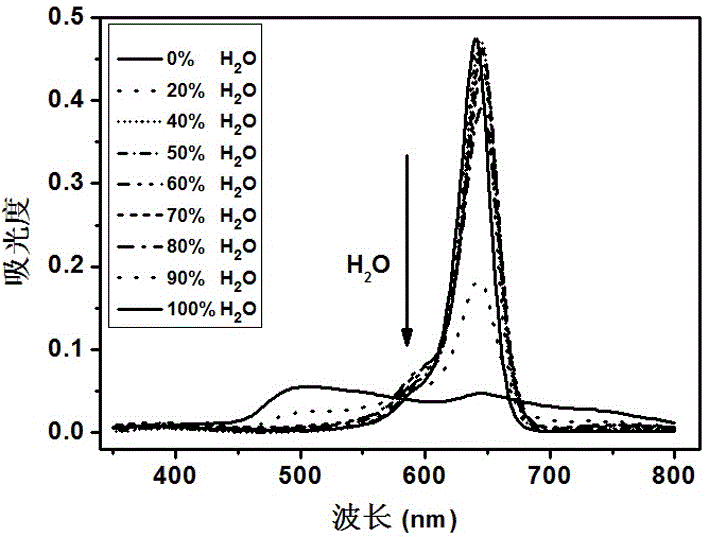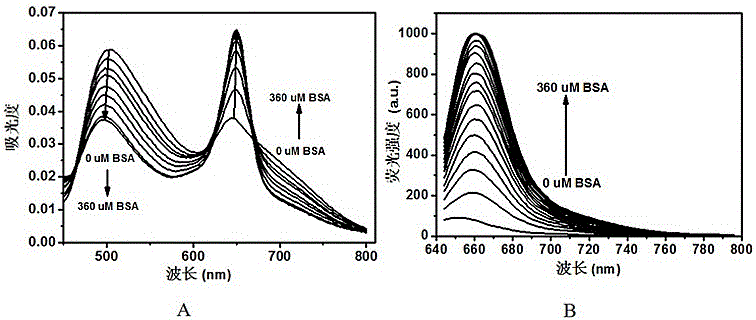Asymmetric near-infrared squaraine dye, preparation method thereof and application thereof
An asymmetric and foreign technology, applied in the field of analytical chemistry, can solve the problems of poor water solubility and limited biomedical applications, and achieve the effects of good stability, improved solubility, and excellent optical properties
- Summary
- Abstract
- Description
- Claims
- Application Information
AI Technical Summary
Problems solved by technology
Method used
Image
Examples
Embodiment 1
[0033] The specific steps of synthesis:
[0034] Add m-aminophenol (0.196 g, 1.80 mmol) into a clean 50 mL three-neck flask, (0.988 g, 3.60 mmol), sodium carbonate (0.267 g, 2.52 mmol), and then add 30 mL of isopropanol-water mixture (1:1, v / v) to dissolve, mix well, stir and heat to 85°C, then reflux for 48 hours, TLC tracking until the raw material point completely disappears, which is the end of the reaction. After the reaction, the isopropanol in the reaction mixture was removed by rotary evaporation. Then the resultant was transferred to a 100 mL separatory funnel, a small amount of saturated saline was added, and then extracted three times with 30 mL of dichloromethane, and the organic layers were combined. Dry the organic layer with anhydrous magnesium sulfate, let it stand, filter to remove magnesium sulfate, and remove excess dichloromethane by rotating the mother liquor. The resulting substance was purified with a silica gel column. First, petroleum ether: ethyl...
Embodiment 2
[0036] The specific steps of synthesis:
[0037] Add m-aminophenol (1.96 g, 18.0 mmol), sodium carbonate (2.76 g, 26.0 mmol), bromoethane (3.92 g, 36.0 mmol) into a clean 100 mL three-necked flask, and then add 60 mL of isopropanol-water The mixed solution (1:1, v / v) was dissolved, mixed evenly, stirred and heated to 85°C under the protection of nitrogen, and then refluxed for 24 hours, followed by TLC until the raw material point completely disappeared, which was the end of the reaction. After the reaction, the isopropanol in the reaction mixture was removed by rotary evaporation. Then the resultant was transferred to a 250 mL separatory funnel, a small amount of saturated saline was added, and then extracted three times with 30 mL of dichloromethane, and the organic layers were combined. Dry the organic layer with anhydrous magnesium sulfate, let it stand, filter to remove magnesium sulfate, and then rotary evaporate to remove excess dichloromethane. The obtained substan...
Embodiment 3
[0039] Asymmetric near-infrared squaraine dyes The specific preparation method is as follows:
[0040] Squaric acid was added to a 100 mL three-necked bottle (43.3 mg, 0.38 mmol), 30 mL of n-butanol and 15 mL of benzene, heated to reflux for about 1 hour under the protection of nitrogen, when there was no obvious separation of water in the water trap, slowly add a small amount of n-butanol dissolved (81.5 mg, 0.26 mmol), after reacting for 20 minutes, add a small amount of n-butanol to dissolve (84.3 mg, 0.51 mmol), under the condition of stirring, the water was separated and refluxed for 2 hours, the reaction was stopped, the reaction mixture was cooled to room temperature, and the solvent was removed under reduced pressure. elution with dichloromethane:methanol (100:1, v / v) to obtain 57.5 mg of the target product with a yield of 40% and a melting point of 154-156 °C. 1 H NMR (400 MHz, CDCl 3 ): δ 12.13(s,1H), 11.43(s,1H), 7.89(s,2H), 6.41(dd, J =9.2, 2.4 Hz, 1H), 6....
PUM
| Property | Measurement | Unit |
|---|---|---|
| The average particle size | aaaaa | aaaaa |
| The average particle size | aaaaa | aaaaa |
Abstract
Description
Claims
Application Information
 Login to View More
Login to View More - R&D
- Intellectual Property
- Life Sciences
- Materials
- Tech Scout
- Unparalleled Data Quality
- Higher Quality Content
- 60% Fewer Hallucinations
Browse by: Latest US Patents, China's latest patents, Technical Efficacy Thesaurus, Application Domain, Technology Topic, Popular Technical Reports.
© 2025 PatSnap. All rights reserved.Legal|Privacy policy|Modern Slavery Act Transparency Statement|Sitemap|About US| Contact US: help@patsnap.com



